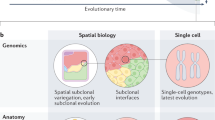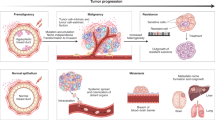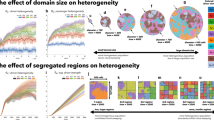Abstract
We propose that carcinogenesis requires tumour populations to surmount six distinct microenvironmental proliferation barriers that arise in the adaptive landscapes of normal and premalignant populations growing from epithelial surfaces. Somatic evolution of invasive cancer can then be viewed as a sequence of phenotypical adaptations to these barriers. The genotypical and phenotypical heterogeneity of cancer populations is explained by an equivalence principle in which multiple strategies can successfully adapt to the same barrier. This model provides a theoretical framework in which the diverse cancer genotypes and phenotypes can be understood according to their roles as adaptive strategies to overcome specific microenvironmental growth constraints.
This is a preview of subscription content, access via your institution
Access options
Subscribe to this journal
Receive 12 print issues and online access
$209.00 per year
only $17.42 per issue
Buy this article
- Purchase on Springer Link
- Instant access to full article PDF
Prices may be subject to local taxes which are calculated during checkout


Similar content being viewed by others
References
Garcia, S. B., Novelli, M. & Wright, N. A. The clonal origin and clonal evolution of epithelial tumors. Int. J. Exp. Path. 81, 89–116 (2000).
Nowell, P. C. The clonal evolution of tumor cell populations. Science 194, 23–28 (1976).
Ilyas, M., Straub, J., Tomlinson, I. P. M. & Bodmer, W. F. Genetic pathways in colorectal and other cancers. Eur. J. Cancer 35, 335–351 (1999).
Fearon, E. R. & Vogelstein, B. A genetic model for colorectal tumorigenesis. Cell 61, 759–767 (1990).
Hanahan, D. & Weinberg, R. A. The hallmarks of cancer. Cell 100, 57–70 (2000).
Gatenby, R. A. & Gillies, R. J. Why do cancers have high aerobic glycolysis? Nature Rev. Cancer 4, 891–899 (2004).
Gatenby, R. A. & Vincent, T. L. An evolutionary model of carcinogenesis. Cancer Res. 63, 6212–6220 (2003).
Gatenby, R. A., Vincent, T. & Gillies, R. Evolutionary dynamics in carcinogenesis. Math. Models Methods Appl. Sci. 15, 1–20 (2005).
Vincent, T. L. & Gatenby, R. A. Modeling cancer as an evolutionary game. Int. Game Theor. Rev. 7, 331–346 (2005).
Gatenby, R. et al. Cellular adaptations to hypoxia and acidosis during somatic evolution of breast cancer. Br. J. Cancer 97, 646–653 (2007).
Isakoff, S. J. et al. Breast cancer-associated PIK3CA mutations are oncogenic in mammary epithelial cells. Cancer Res. 65, 10992–11000 (2005).
Derksen, P. W. B. et al. Somatic inactivation of E-cadherin and p53 in mice leads to metastatic lobular mammary carcinoma through induction of anoikis resistance and angiogenesis. Cancer Cell 10, 437–449 (2006).
Eckert, L. B. et al. Involvement of Ras activation in human breast cancer cell signaling, invasion, and anoikis. Cancer Res. 64, 4585–4592 (2004).
Ishida, H. et al. Critical role of estrogen receptor on anoikis and invasion of squamous cell carcinoma. Cancer Sci. 98, 636–643 (2007).
Carroll, D. K. et al. p63 regulates an adhesion program and cell survival in epithelial cells. Nature Cell Biol. 8, 551–560 (2006).
Hofmann, C. et al. Cell–cell contacts prevent anoikis in primary human colonic epithelial cells. Gastroenterology 132, 587–600 (2007).
Sporn, M. B. & Roberts, A. B. Autocrine growth factors and cancer. Nature 313, 745–747 (1985).
Arteag, C. L. Epidermal growth factor receptor dependence in human tumors: more than just expression? Oncologist 4, 31–39 (2002).
Cantley, L. C. et al. Oncogenes and signal transduction. Cell 64, 281–302 (1991).
Sarkisian, C. J. et al. Dose-dependent oncogene-induced senescence in vivo and its evasion during mammary tumorigenesis. Nature Cell Biol. 9, 493–505 (2007).
Smallbone, K., Gatenby, R. A., Gillies, R., Maini, P. & Gavaghan, D. Metabolic changes during carcinogenesis: potential impact on invasiveness. J. Theor. Biol. 244, 703–713 (2007).
Rubin, H. Multistage carcinogenesis in cell culture. Dev. Biol. 106, 61–66 (2001).
Burger, A. M. et al. Effect of oncogene expression on telomerase activation and telomere length in human endothelial, fibroblast and prostate epithelial cells. Int. J. Oncol. 19, 1043–1048 (1998).
Robey, I. F., Lien, A. D., Welsh, S. J., Baggett, B. K. & Gillies, R. J. Hypoxia-inducible factor-1α and the glycolytic phenotype in tumors. Neoplasia 7, 324–330 (2005).
Gillies, R. J. & Gatenby, R. A. Hypoxia and adaptive landscapes in the evolution of carcinogenesis. Cancer Metastasis Rev. 26, 311–317 (2007).
Park, H. J., Lyons, J. C., Ohtsubo, T. & Song, C. W. Acidic environment causes apoptosis by increasing caspase activity. Br. J. Cancer 80, 1892–1897 (1999).
Gatenby, R. A. & Gawlinski, E. T. A reaction-diffuse model of acid-mediated invasion of normal tissue by neoplastic tissue. Cancer Res. 56, 5745–5753 (1996).
Rohzin, J., Sameni, M., Ziegler, G. & Sloane, B. F. Pericellular pH affects distribution and secretion of cathepsin B in malignant cells. Cancer Res. 54, 6517–6525 (1994).
Abbey, C. K. et al. In vivo PET imaging of progression of transformation in a mouse model of mammary neoplasia. Proc. Natl Acad. Sci. USA 101, 11438–11443 (2005).
Yasuda, S. et al. 18F-FDG PET detection of colonic adenomas. J. Nucl. Med. 42, 989–992 (2001).
Younes, M., Ertan, A., Lechago, L. V., Somoano, J. & Lechago, J. Human erythrocyte glucose transporter (Glut1) is immunohistochemically detected as a late event during malignant progression in Barrett's metaplasia. Cancer Epidemiol. Biomarkers Prev. 6, 303–305 (1997).
Folkman, J. Role of angiogenesis in tumor growth and metastasis. Semin. Oncol. 29, 15–18 (2002).
Naumov, G. N. et al. A model of human tumor dormancy: an angiogenic switch from the nonangiogenic phenotype. J. Natl Cancer Inst. 98, 316–325 (2006).
Giuriato, S. et al. Sustained regression of tumors upon MYC inactivation requires p53 or thrombospondin-1 to reverse the angiogenic switch. Proc. Natl Acad. Sci. USA 103, 16266–16271 (2006).
Gatenby, R. A. et al. Acid-mediated tumor invasion: a multidisciplinary study. Cancer Res. 66, 5216–5223 (2006).
Author information
Authors and Affiliations
Corresponding authors
Rights and permissions
About this article
Cite this article
Gatenby, R., Gillies, R. A microenvironmental model of carcinogenesis. Nat Rev Cancer 8, 56–61 (2008). https://doi.org/10.1038/nrc2255
Issue Date:
DOI: https://doi.org/10.1038/nrc2255
This article is cited by
-
Component prediction in combined hepatocellular carcinoma-cholangiocarcinoma: habitat imaging and its biologic underpinnings
Abdominal Radiology (2024)
-
Convergent TP53 loss and evolvability in cancer
BMC Ecology and Evolution (2023)
-
Evolutionary determinants of curability in cancer
Nature Ecology & Evolution (2023)
-
Molecular mechanisms in colitis-associated colorectal cancer
Oncogenesis (2023)
-
Unraveling the Drivers of Tumorigenesis in the Context of Evolution: Theoretical Models and Bioinformatics Tools
Journal of Molecular Evolution (2023)



